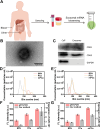Dumbbell Dual-Hairpin Triggered DNA Nanonet Assembly for Cascade-Amplified Sensing of Exosomal MicroRNA
- PMID: 38708273
- PMCID: PMC11064005
- DOI: 10.1021/acsomega.4c02652
Dumbbell Dual-Hairpin Triggered DNA Nanonet Assembly for Cascade-Amplified Sensing of Exosomal MicroRNA
Abstract
Exosomal microRNAs (miRNAs) are valuable biomarkers closely associated with cancer progression. Therefore, sensitive and specific exosomal miRNA biosensing has been employed for cancer diagnosis, prognosis, and prediction. In this study, a miRNA-based DNA nanonet assembly strategy is proposed, enabling the biosensing of exosomal miRNAs through dumbbell dual-hairpin under isothermal enzyme-free conditions. This strategy dexterously designs a specific dumbbell dual-hairpin that can selectively recognize exosomal miRNA, inducing conformational changes to cascade-generated X-shaped DNA structures, facilitating the extension of the X-shaped DNA in three-dimensional space, ultimately forming a DNA nanonet assembly. On the basis of the target miRNA, our design enriches the fluorescence signal through the cascade assembly of DNA nanonet and realizes the secondary signal amplification. Using exosomal miR-141 as the target, the resultant fluorescence sensing demonstrates an impressive detection limit of 57.6 pM and could identify miRNA sequences with single-base variants with high specificity. Through the analysis of plasma and urine samples, this method effectively distinguishes between benign prostatic hyperplasia, prostate cancer, and metastatic prostate cancer. Serving as a novel noninvasive and accurate screening and diagnostic tool for prostate cancer, this dumbbell dual-hairpin triggered DNA nanonet assembly strategy is promising for clinical applications.
© 2024 The Authors. Published by American Chemical Society.
Conflict of interest statement
The authors declare no competing financial interest.
Figures





References
LinkOut - more resources
Full Text Sources
